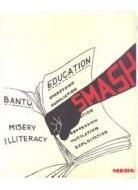"E tshwana (sic) le phate ea mahlatsa ha e tshelwa (sic) sefahlehong sa ngwana wa motho e motsho."
(It's like vomit poured onto the face of a black child)
- Curtis Nkondo's description of Bantu Education.
The Soweto Uprising of June 1976 was a major turning point in the struggle against apartheid. Many regard it as the beginning of the end of apartheid. It represented the biggest single challenge to the apartheid state and from this point on; the government was unable to ignore the growing tide of resistance.
In order to understand the events of 1976, it is important to understand the context in which these events happened. In the early 1970s, the economy was in a state of decline and inflation and unemployment was high. In Soweto especially, but also in other black townships, housing was unable to keep up with the influx of people from the rural areas, and there was massive overcrowding and a general lack of facilities. This led to frustration and anger as the living standards of residents declined substantially. However, it was not until the anger of black students was mobilised that action against these circumstances was taken.
For black high school students thier future looked bleak. Their schools were overcrowded, under-resourced and many teachers had resorted to strong disciplinary measures in order to maintain control. Very little learning was taking place. This was made worse by the government’s decision in 1975 to introduce Afrikaans as a medium of instruction in schools, whereby all schools had to teach half of their subjects in Afrikaans.
This led to a crisis on two counts. Firstly, most teachers were unable to teach in Afrikaans, and for the students, Afrikaans was usually a third or fourth language.This meant that students would inevitably fail their matriculation examinations and be forced to join the ranks of the unemployed. Secondly, Afrikaans was seen as the ‘language of the oppressor’ and raised the anger of the students.
Despite months of appeals and objections by parents, the state continued with its policy. At the beginning of 1976, students began to mobilise around the issue of Afrikaans but still the government refused to respond to these protests. This eventually led to the march of thousands of students in Soweto to Orlando Stadium on 16 June, 1976 where they planned to hand over their objections to Afrikaans in a petition.
The police fired on this peaceful crowd of students. The first child to be killed was Hector Petersen. The shootings continued. The killings did not deter the protestors. In fact, it gave many students the courage to continue. While students confronted the police in running battles, they also targeted some of the symbols of oppression. They burnt down the offices of the West Rand Administration Board (WRAB), which was seen as a symbol of the white man’s control of their lives. They also burnt down beer halls. These were controlled by the government and were seen as places where adults went to get drunk, rather than confront the apartheid state.
The government sent in troops to Soweto to try and stop the unrest. But protest and action continued over the next three months. The events of Soweto also inspired youth all over, and unrest broke in townships all around the country. In the ensuing violence, about 300 black youths were killed and over 2000 injured. The youth had paid a very high price in their struggle against Bantu education.
Exhibitions in the classroom
Visualising the past
SOURCE: “The death of Hector Pieterson, Soweto, 16 June 1976.” Photograph by Sam Nzima.
The famous image of Hector Pieterson being carried by Mbuyisa Makhuba alongside his sister has become the symbolic image of the Soweto uprising. If you look at the posters on this panel, they have all used the image to commemorate June 16.
- Why do you think that this image holds such power for people? Refer to elements in the image to explain your answer.
- Some people have suggested that this image has created an impression that Hector Petersen was the only young child to die, and that by using this image for June 16, the other young people who died are not remembered. Do you agree with this or not? Discuss this in groups.
- Which poster do you think is the most effective as a poster to commemorate June 16? Refer to elements in the poster to justify your answer.
- What impression do you gain of the protests on June 16 from the photograph of the youth marching? Refer to elements in the photograph to explain your answer.
Reading the past
Read the quotation by Curtis Nkondo, above on Bantu Education. Do you think he is justified to talk about Bantu Education in such vicious terms? Provide evidence on the nature of Bantu Education to justify your answer.


















